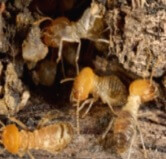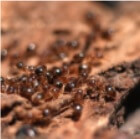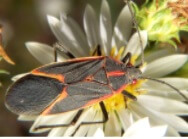They’re creepy and kooky – but nowhere near as endearing as the Addams Family. I’m talking about all the multi-legged critters eager to take up residence in your home, RV camper or other off-limits areas during the cool fall and winter months. From ants hitchhiking on your firewood to spiders hiding out in your shoes – when the weather gets cold outside, many insects will be busily looking for a place to call home for the season. In fact, some may already be making their way inside! What can be done about this situation? Battling bugs outside is already a pain but dealing with them inside can truly be a nightmare, especially when all you want to do is get cozy by the fireside. But the good news is that warding off winter pests this year doesn’t have to be difficult. By reading this article, you have taken the first step to educate yourself which is great! Lets take a moment to learn some of the top places where bugs like to hang out in the winter, and explore various practical steps to shut them down to ensure the winter is comfy and pest-free.
Insects In Firewood
There’s nothing quite like the smell of firewood crackling in a den – sweet and earthy, it warms the room and just makes you feel good. Unfortunately, many insects like firewood just as much as we do! Hopping a ride on firewood bundles is one of the most overlooked ways that bugs make their way into your home.
Firewood attracts many types of insects. Damp wood is a favorite hideout for carpenter ants and termites. Wood that’s been in contact with the ground (ie. In a backyard wood pile) may be infested by sow bugs, millipedes, centipedes and other characters. Dry wood provides a comfy home for beetles and a host for their eggs, which can produce beetles a few years after the wood was cut. Wasps – commonly affiliated with summer warmth – also lay eggs in the wood and larvae may emerge when the wood’s brought inside.
If you’re like us, none of the above sounds like any fun! The good news is it’s all relatively easy to prevent these problems.
- Harvest firewood after October and before April: Insects are less active during these cooler months, and wood cut at this time has a lower chance of being infested. Be warned: Freshly cut wood is a welcome mat for insects, so once you cut it, bring it inside as soon as possible.
- Keep your wood dry: Growing up, we kept our wood in a huge pile in the backyard – there was no way Mom was letting that stuff hang out in our basement! If you too lack a shelter for your wood, create one: Place a tarp over your wood pile. This will at minimum keep the wood dry and make it less inviting to bugs. Make sure to keep some air space beneath the tarp to promote quicker drying if your wood is already wet.
- Invest in a wood rack: Once you’ve gotten your wood into a garage, shed or some other sheltered place, you’re still not in the clear. Bugs love to come in through cracks and crevices, and wood lying on the ground makes a nice home. Get a good wood rack or take other steps to raise wood off the ground.
Protecting Your RV Campers From Insects
The summer’s long gone and your fabulous RV is parked for the duration. Just lock the door and forget it, right? Not so fast: Pests and insects are notorious for invading RVs during those long winter months. Leftover crumbs, not quite clean refrigerators, wires and even additives in your RV’s propane can make your camper a seductive hideaway for winter pests.
Don’t open your camper door in the spring to find a mess. Take these steps to keep those pesky ants away and send other bugs running from your camper.
- Invest in ant deterrents: Ants are one of the most common RV invaders. With their tiny size, ants are able to squeeze through just about any opening in your RV. That makes patching holes fairly useless – those critters will still find a way!
- Invest in ant traps or, for an added level of security, sprinkle a product like Amdro Ant Block around your camper to form a sort of protective moat.
- Close/cover propane lines inside and outside: The scent of propane has an intoxicating effect on spiders. They love it! Great for them, bad for you: These guys will nest in your propane appliances, orifice tubes and venturis. If you can, remove propane tanks from the unit and find a way to close the line on the outside. Check your local hardware store – they often carry caps for just this occasion. Inside, close, cover or fill any propane-related opening. Try wrapping stove burners in plastic and close the area around the line with a twist tie. Make sure you remove all of these things in the spring before trying to relight all of these systems!
- Deep clean: You’ve heard of spring cleaning, well winter RV cleaning is a must. Get down and dirty with your refrigerator, cabinets, counters, tabletops. No bit of food is too small to attract an insect. Wipe things down with a strong cleanser and leave all cabinets and your refrigerator open.
Keeping Insects Away From HVAC Systems
Usually, for many of us, it’s not truly the cold season until temperatures force us to turn on the heat. Unfortunately, when some of us turn on our heat, we may discover an unwelcome surprise – box elder bugs. These red and black guys are mostly harmless, but their tendency to swarm together and congregate near homes can be a big problem in the summer. During the winter, robbed of the box elder and maple buds that they host upon, these critters will often seek shelter in the HVAC of a nearby house. Prevention of these insects can be difficult; they are attracted to light-colored homes and maple trees.
- Seal internal entry points: Areas around window frames, door frames and base boards are typical entry points for box elder bugs. Seal these with silicone caulk or a similar material. Where possible, remove cover plates surrounding electrical outlets, heating duct and air return vents and replace them, making sure to have a good seal.
- Take external prevention steps: Cover all vents (roof, gable, eave, etc.) with at least 16-mesh screening. Stuff weep holes with copper gauze or steel wool; apply silicone sealant around cable and utility penetrations, windows, doors and overhangs. Take note: These steps are best taken before late August.
The cooler fall and winter months are typically considered a time to hunker down, stay put and enjoy your comfortable home. That shouldn’t include battling overwintering pests. With the above steps and a little vigilance, you can be sure your cozy nights won’t involve any buggy critters!
Hello! My name is Natasha, and I have been helping people with their insect problems since 2012. I have published a book, worked with many pest control companies, and helped thousands with various infestations on a one-to-one basis. My goal for this blog is to create evidence-based guides that are easy to understand, provide sufficient depth and can be trusted to be very accurate. Please remember that my guides are for informational purposes only, and that you agree to the terms of use when reading content on this website. If you leave a comment, I typically respond within 48 hours.







OMG !!! its funny when your bio pop up and it said Natasha Anderson……This is my sister name also..WOW
Hey Kim! Wow that is pretty damn crazy, small world hehe. I hope she is not also into insects because that would be pretty creepy (literally) 😉